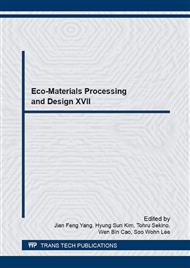[1]
J. Winzer, L. Weiler, J. Pouquet, J. Rodel, Wear behaviour of interpenetrating alumina–copper composites, Wear. 271 (2011) 2845– 2851.
DOI: 10.1016/j.wear.2011.05.042
Google Scholar
[2]
R. Ramesh, A. S. Prasanth, M. Ragavan, M. Likhith, SiC/Aluminium co-continuous composite synthesized by reactive metal penetration, Appl. Mech. Mater. 592-594 (2014) 847-853.
DOI: 10.4028/www.scientific.net/amm.592-594.847
Google Scholar
[3]
Q. Liu, F. Ye, Y. Gao, S. Liu, H. Yang, Z. Zhou, Fabrication of a new SiC/2024Al co-continuous composite with lamellar microstructure and high mechanical properties, J. Alloy Compd. 585 (2014) 146-153.
DOI: 10.1016/j.jallcom.2013.09.140
Google Scholar
[4]
J. Binner, H. Chang, R. Higginson, Processing of ceramic-metal interpenetrating composites, J. Eur. Ceram. Soc. 29 (2009) 837–842.
DOI: 10.1016/j.jeurceramsoc.2008.07.034
Google Scholar
[5]
P. Gao, X. Zhang, J. Liu, S. Huang, W. Xie, H. Xiao, Microstructure and properties of MoSi2-RSiC composites prepared by PIP and MoSi2-Si-Al alloy melting infiltration composite process, Key Eng. Mater. 602-603 (2014) 494-498.
DOI: 10.4028/www.scientific.net/kem.602-603.494
Google Scholar
[6]
R. Gil, A. R. Kennedy, Capillarity-driven infiltration of alumina foams with an Al-Mg alloy: processing, microstructure, and properties, J. Mater. Eng. Perform. 21(5) (2012) 714-720.
DOI: 10.1007/s11665-012-0147-x
Google Scholar
[7]
S. Roy, J–M. Gebert, G. Stasiuk, R. Piat, K. A. Weidenmann, A. Wanner, Complete determination of elastic moduli of interpenetrating metal/ceramic composites using ultrasonic techniques and micromechanical modelling, Mater. Sci. Eng. A 528 (2011).
DOI: 10.1016/j.msea.2011.07.029
Google Scholar
[8]
H. Chang, R. Higginson, J. Binner, Microstructure and property characterisation of 3-3 Al(Mg)/Al2O3 interpenetrating composites produced by a pressureless infiltration technique, J. Mater. Sci. 45 (2010) 662–668.
DOI: 10.1007/s10853-009-3983-9
Google Scholar
[9]
H. A. Abdulhaqq, P. K. Ghosh, S. C. Jain, S. Ray, Influence of particle content and porosity on the wear behavior of cast in-situ Al(Mn)−Al2O3(MnO2) composite, Wear. 260(4−5) (2006) 368−378.
DOI: 10.1016/j.wear.2005.02.120
Google Scholar
[10]
D. Dong, X. Liu, W. Hu, Investigation on viscosity of silica sol catalyzed by nitric acid, Rare Metal Mater. Eng. 39( Suppl. 2) (2010) 99-102.
Google Scholar


